Viktor Andreevich Zhelobkovich was 8 years old at the time. He’d recall decades later that the invading Nazi troops and their collaborators forced him, his mother and the other residents of Khatyn, a tiny village in Belarus, to wait in a barn for about an hour while the enemy plotted outside. Though they tried to convince themselves that the soldiers were just trying to scare them, glimpses of gasoline being poured on stacks of hay outside suggested otherwise.
“People went out of their minds from fear, realizing that they were to be burned,” Zhelobkovich said. Soon after the barn went up in flames, its roof collapsed, prompting the desperate villagers to break down the locked doors and run outside, where they were easy targets for the machine gun–wielding attackers.
Zhelobkovich’s mother saved his life. “I wanted to get up,” he said, “but she pressed my head down: ‘Don’t move, son, lie still.’ Something hit me hard in my arm. I was bleeding. I told my mom, but she didn’t answer—she was already dead.”
He added:
Everything around me was burning, even my mother’s clothes had begun to glow. Afterwards I realized that the punitive squad had left and the shooting had ended, but still I waited awhile before I got up. The barn burned down, burned corpses lay all around. Someone moaned: “Drink.” I ran, brought water, but to no avail, in front of my eyes the Khatyn villagers died one after another.
Another survivor, Vladimir Antonovich Yaskevich, managed to hide in a pit used to store potatoes. Two German soldiers discovered the 13-year-old but departed without shooting him. Later, when he emerged from the pit and saw the smoldering ruins of his home, he held out hope that his family had escaped to the forest. When morning came, however, he saw nothing but charred bones. “Among the burned corpses,” Yaskevich said, “I recognized the bod[ies] of my father, brothers and sisters.”
/https://tf-cmsv2-smithsonianmag-media.s3.amazonaws.com/filer/79/c9/79c97d50-c0d4-460e-9cf3-215be96cfda0/sophia_and_vladimir_yaskevich_2.jpg)
The March 22, 1943, massacre at Khatyn (pronounced HA-teen) left 149 villagers from the Eastern European community, then part of the Soviet Union, dead. Just six people—five children and one adult—survived. Ostensibly in reaction to Belarusian partisans’ ambush killing of German Olympic shot putter Hans Woellke, Nazi soldiers and their collaborators converged on the village and enacted total warfare on its civilian inhabitants. As described so vividly by Zhelobkovich, the attackers herded all of the villagers into a large barn, set the building on fire and then waited outside with machine guns. Those who managed to escape the inferno were quickly mowed down. Before departing, the Germans looted everything of value and burned Khatyn to the ground.
It was far from an isolated incident. By one historian’s count, occupying forces murdered all the inhabitants of 629 razed Belarusian villages, in addition to burning down another 5,454 villages and killing at least a portion of their residents. As Peter Black, former senior historian at the United States Holocaust Memorial Museum, explains, these punitive operations paved the way for the planned repopulation of Soviet territory with German settlers. The Nazis, he says, hoped to conquer, secure and exploit the Soviet Union’s resources, “both natural and human, … for the benefit of the German Reich.”
Though it looms large in the Belarusian cultural consciousness, Khatyn—and the scope of devastation it speaks to—is relatively unknown in Western Europe and the United States. Per Anders Rudling, a historian at Lund University in Sweden, notes that Nazi reprisals at Lidice and Oradour-sur-Glane, villages in Czechoslovakia and France, respectively, “are rather well known in the West because [they] took place in a Western setting.” But the fact that massacres of this kind, isolated incidents within their countries, took place “on a scale incomparably greater” in the Soviet Union is largely overlooked, he says.
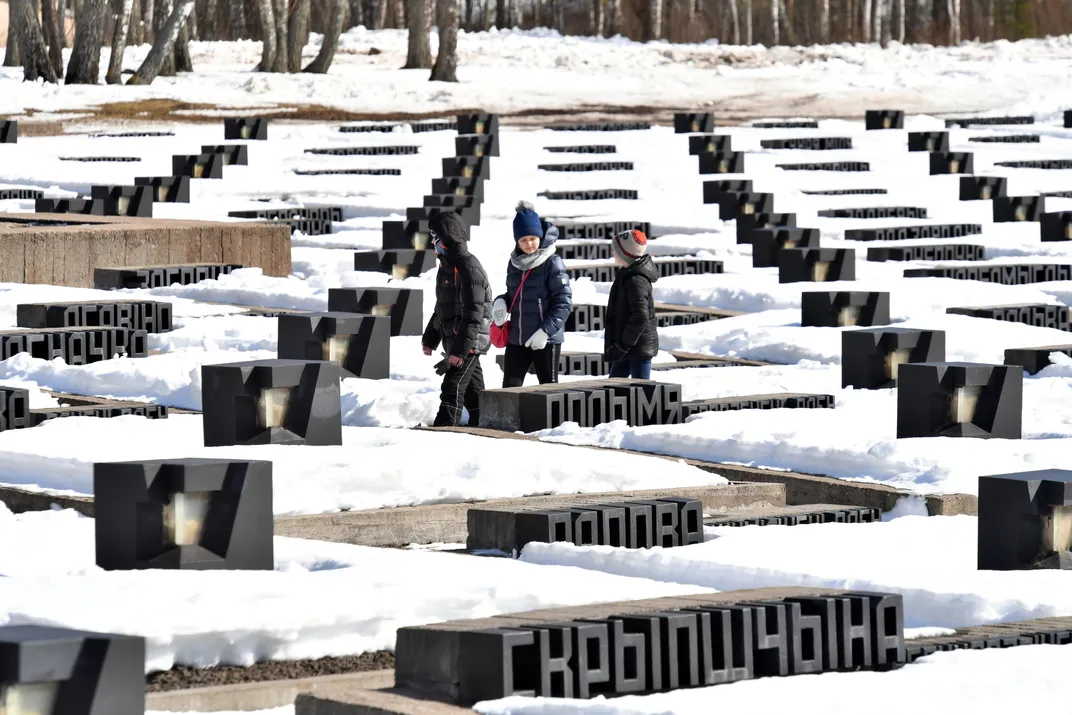
In the broader story of the Nazi invasion of the Soviet Union, the tragedy of Khatyn left deep scars that continue to resonate today. Far from being a clear narrative of good and evil, of Nazi atrocity and Soviet bravery, the events of the massacre—and the way it became a symbol in the post-war era—instead represent a prism through which to examine the power of nationalism, patriotism and historical memory.
As German forces bore down on the Soviet Union in the summer of 1941, Wilhelm Keitel, head of the Nazi armed forces’ high command, issued an ominous directive: “Since we cannot watch everybody, we need to rule by fear.”
Keitel’s comment reflected the stark reality of life on the Eastern Front. Though some 78 percent of Adolf Hitler’s soldiers were stationed there, the sheer size of the Soviet Union left Germany’s troops spread too thin, says Rudling.
Beyond the challenges posed by the massive Soviet army, the Germans also struggled with attacks by partisans, or ragtag bands of resistance fighters who relied on guerrilla tactics to disrupt the occupation. To discourage resistance against outnumbered German soldiers, Keitel ordered the deaths of 50 to 100 Soviets for every Nazi killed by partisans.
The brutal policy, enforced with the help of local collaborators, served a dual purpose, quelling uprisings while enabling the mass murder of Eastern Europe’s Slavs, the dominant ethnic group in the region, whom the Germans viewed as inferior and targeted as they did the continent’s Jews. (Though the Holocaust claimed the lives of 2.6 million Jews from the Soviet Union, post-war U.S.S.R. authorities tended ignore the victims’ faith in favor of grouping them with other Slavs as part of a broader narrative of genocide against peaceful Slavic citizens, notes Black.)
“It cannot be emphasized strongly enough that what happened on the Eastern Front was a war of racial extermination,” says Rudling. “And Hitler made it very clear that it was a different conflict than what they called the European ‘normal war’ in the West,” where the Nazis were more concerned with keeping conquered countries dependent on Germany than in waging a campaign of total annihilation.
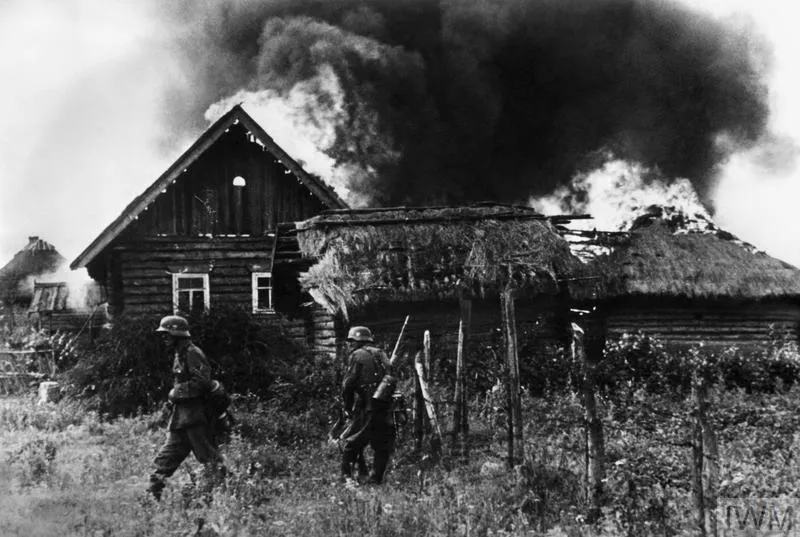
Belarus, then known as Belorussia, bore much of the brunt of this systematic violence, with an estimated 2.2 million Belarusians—around one in four—dying during World War II. The scale of the country’s population loss, writes historian David R. Marples, was “proportionally higher than practically any other theater of war.”
Rudling attributes the Nazis’ “particularly brutal” occupation of Belarus to two key factors: First, the country was home to a thriving community of Ashkenazi Jews (90 percent of whom were killed during the Holocaust), and second, its landscape of swamps and forests was well suited for guerrilla warfare. Acts of resistance by partisans led, in turn, to widespread massacres of civilians—like what happened in Khatyn, located around 30 miles north of the capital city of Minsk.
Diaries, archival records and eyewitness accounts studied by Rudling suggest that a group of 75 Belarusian partisans ambushed the Schutzmannschaft Battalion 118, an auxiliary unit dominated by collaborationist Ukrainians, on the morning of March 22. For every German soldier stationed on the Belarusian front line, between 15 and 20 collaborators were on hand to help oversee occupied territory and quash partisan resistance. Acting alternatively out of ambition, nationalism, anti-Semitism, anti-communism sentiment or self-preservation, these individuals came largely from western Ukraine, Lithuania and Latvia, where loyalty to the Soviets was low-to-nonexistent due to atrocities committed under premier Joseph Stalin, including the intentional starvation of 3.9 million Ukrainians. (Though Belarusian collaborators existed, none were present at Khatyn specifically, according to Black.)
In the fighting that morning, the partisans killed four men, among them the Olympian Woellke. A journal kept by a partisan brigade reports that they “rested” in Khatyn after the attack; by the time the soldiers arrived, all of the partisans had departed, leaving just civilians in the village. Though the Nazis and their collaborators could have pursued the partisans, they decided not to, perhaps out of fear of meeting another ambush. Instead, says Artur Zelsky, director of the Khatyn State Memorial Complex, “They got down to … safer, but more terrible work—looting and extermination of innocent people.”
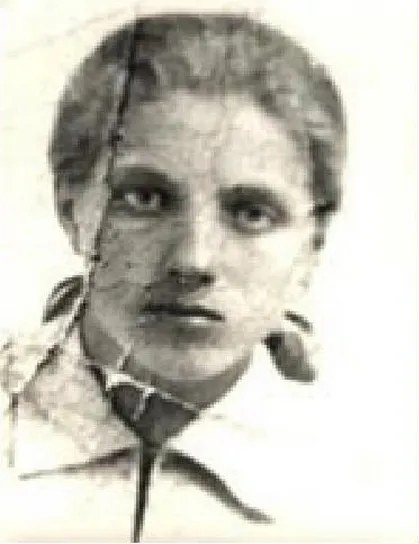
The Khatyn memorial’s website lists extensive information about the attack, including the names and birth years of the 149 victims. But details on the perpetrators’ identities, as well as the events leading up to the killings, are sparse: The page simply states that “German fascists”—with no mention of Ukrainian collaborators—murdered the village’s innocent residents.
Official government accounts of Khatyn and other wartime massacres tend to obscure the role of Nazi collaborators while celebrating the actions of Belarusian partisans, who are widely lauded as patriotic heroes. Recent research, however, complicates this narrative. As Alexandra Goujon, a political scientist at the University of Burgundy in France, points out, some partisan activity amounted to little more than pillaging, rape and murder. The targets of their attacks weren’t just Nazis, she adds, but suspected collaborators and locals who refused to support the partisan movement. Moreover, all partisan action was undertaken with the full awareness that the Nazis would target innocent civilians in retaliation.
“The partisan knows that if they are going to hide in a village, this village might be burned,” says Goujon.
/https://tf-cmsv2-smithsonianmag-media.s3.amazonaws.com/filer/9d/62/9d6219b4-760e-469e-b152-a0058c604288/victor_zhelobkovich_.jpg)
The fact that the March 22 ambush’s victims included an Olympic medalist likely factored into the severity of the reprisal meted out. As Rudling recounts, the battalion’s leader, Erich Körner, dispatched his men, as well as reinforcements from the Dirlewanger Brigade, a German unit known for its brutality, to Khatyn. Though Körner reported that “[t]he enemy put up fierce resistance and opened fire from all houses in the village,” necessitating his men’s use of anti-tank guns and heavy grenade launchers, eyewitness accounts leave no doubt that the killings were an outright massacre.
In the years following the war, the tragedy of Khatyn faded from memory, rendered banal by the scale of devastation wrought in Belarus. The majority of the roughly 250 men responsible for the Khatyn massacre never faced repercussions. “Most of the members of the 118th [Battalion] survived the war [and] post-war retaliation,” says Black. “Some of them fled to the West. Some of them returned to the Soviet Union to take up their old lives,” often under false names.
Just three individuals involved in the killings—including two Ukrainians who’d received commendations for the operation—were executed for their crimes. One Ukrainian collaborator, Vladimir Katriuk, moved to Canada, where he worked as a beekeeper. Katriuk died in 2015, at age 93, just two weeks after Russia requested his extradition.
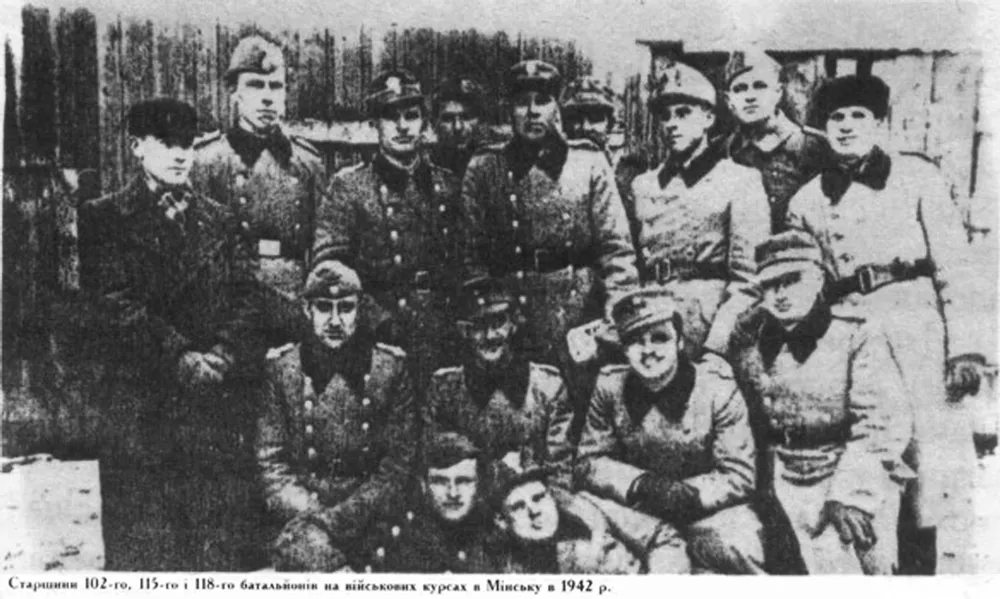
This historical amnesia changed in the mid-1960s, when Pyotr Masherov, leader of the Belorussian Communist Party and a former partisan himself, came to power. Emphasizing wartime resistance as a central aspect of Belarusian identity, Masherov oversaw the erection of monuments commemorating the conflict’s dead and celebrating partisan heroism—a strategy that “stressed [his government’s] own legitimacy and heroism,” says Rudling.
Masherov and the politicians who followed him, including current President Alexander Lukashenko, cultivated a narrative that paints Belarusian heroism, as exemplified by partisans, as unmatched “in the entire war history and … therefore deserving of praise the world over,” according to Goujon. Omitted from this version of events, she adds, are foundational aspects of Belarusians’ wartime experiences: namely, partisan violence against civilians, the existence of local collaborators who helped the Nazis commit atrocities and “the fact that many people avoided taking sides during the war.”
Goujon argues, “Any attempt to construct a more complex picture of Belarusian partisan warfare than the state’s black-and-white narrative of WWII is [considered] a threat.”
Khatyn’s transformation into a symbol of broader Belarusian suffering coincided with the creation of a new founding myth for the Soviet Union—one that painted the so-called Great Patriotic War in broad, nationalistic strokes. Instead of acknowledging the singular suffering experienced by victims of the Holocaust, officials grouped the genocide of Soviet Jews with the killings of ethnic Slavs, ignoring underlying differences in favor of presenting a unified front. The Holocaust, according to Rudling, could not be allowed to overshadow the myth of the Great Patriotic War.
/https://tf-cmsv2-smithsonianmag-media.s3.amazonaws.com/filer/f7/3f/f73f4e55-6d05-4e6e-8030-867cc4ecbc26/iosif_kaminsky__at_the_monument_grieving_mother_at_the_grave_of_the_victims__of_khaty_1960s.jpg)
“The Soviet narrative was very much a replacement for the memory of the [October] Revolution,” says Simon Lewis, a cultural historian at the University of Bremen’s Institute for European Studies in Germany. “… And when you create this narrative of glory against ‘fascism’ and victory, of pretty much saving the world actually, then these other events [like the Holocaust] don’t seem so relevant anymore. They’re a bit of a nuisance to the master narrative of they, the Nazis, being the bad guys, and [us] defeating them.”
The Khatyn State Memorial Complex, established in 1969 by the U.S.S.R., epitomizes the monumental nature of this new founding myth. Designed to honor not just Khatyn, but all of Belarus’ wartime victims, the 50-hectare site—equivalent to ten football fields—features a symbolic cemetery with soil from the 186 villages that were never rebuilt, a black marble “Wall of Sorrow” and an eternal flame representing the one in four Belarusians who died during the war. Funded by the state, the memorial echoes government talking points, with an official tour guide telling visitors that the villagers were targeted because “they were Belorussians with honest hearts who wanted to live in their dear Fatherland and work their land without any fascist ‘new order.’”
At the entrance to the complex, a 20-foot-tall statue of Iosif Kaminsky, the only adult to survive the massacre, stares ahead stoically while holding the body of his murdered son. A seeming testament to Belarusian endurance in the face of tragedy, the sculpture’s “spirited invincibility,” as Lewis wrote in a 2015 paper, offers a stark contrast to Kaminsky’s own mournful account of the attack. Despite being severely injured, he managed to reach his son, who had called out for help. “I crawled over, lifted him slightly, but saw that bullets had ripped him in half,” Kaminsky recalled in 1961. “My son Adam managed to ask ‘is Mummy still alive?’ and then he died on the spot.”
/https://tf-cmsv2-smithsonianmag-media.s3.amazonaws.com/filer/4b/86/4b86a55d-6bbc-4eb2-a70e-d41f206e6b56/gettyimages-1131958435.jpg)
Upon seeing the statue, titled Unbowed Man, at the memorial’s opening ceremony, Kaminsky again struck a different tone “from the measured pathos of the party officials,” noted Lewis in 2015. Crying, he simply said, “Every time I think of Khatyn, my heart spills over. … All that was left of the village was chimneys and ash.”
Why Khatyn, out of the thousands of burned villages in Belarus, was chosen for elevation is a point of contention. Multiple scholars have argued that the site was selected because of its name’s similarity to Katyń, the site of a 1940 Soviet massacre of upward of 20,000 Polish prisoners of war. Given that it took until 1990 for Soviet authorities to admit to those killings, which they’d tried to pin on invading German forces, the idea that they picked Khatyn to sow confusion is “not unlikely,” according to Rudling, but has not been confirmed.
The Khatyn-Katyń debate touches on an aspect of local history omitted from the memorial complex, as well as the broader state narrative: namely, the Soviets’ own repression of Belarus in the years preceding the Nazi occupation. When the Germans invaded, some Belarusians actually welcomed them as liberators. Among other atrocities, the Soviet secret police had executed more than 30,000 Belarusian civilians in Kurapaty, a wooded area outside of Minsk, as part of Stalin’s Great Purge of dissenters in the late 1930s.
“The Stalinist terror instilled fear and paralyzed society,” says Rudling. But the sheer brutality of the Nazi occupation led most Belarusians to “remember this selectively,” he adds, with the restoration of Soviet rule viewed as a “legitimate liberation.” The rise of the cult of the Great Patriotic War in the 1960s, coupled with seismic improvements in Belarusians’ quality of life, further contributed to this phenomenon of selective memory.
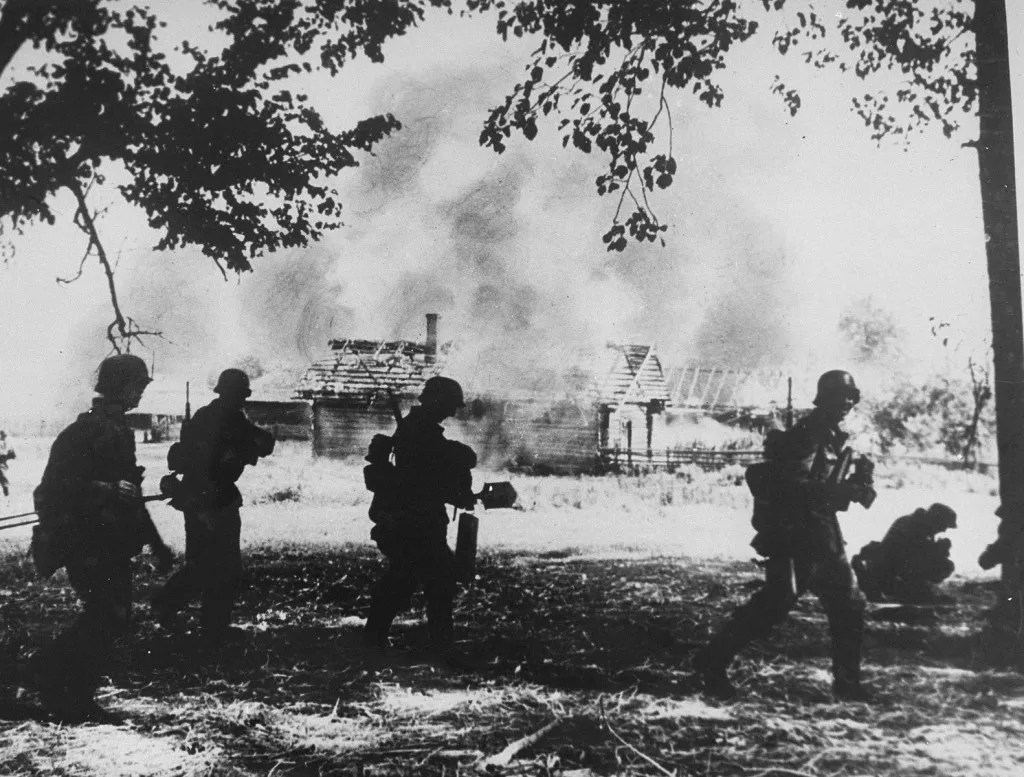
“For many Belarusians, the Soviets brought civilization, modernity, social advancement, technology, healthcare, literacy and all that jazz,” Rudling explains. Today, he adds, Belarusian President Lukashenko capitalizes on this fondness for the Soviet Union as he attempts to model his own regime on that of Russian President Vladimir Putin. By portraying Belarusians’ wartime suffering as the result of Nazi genocide against Slavs, Lukashenko appeals to “the Slavic ethnic base as a focus of loyalty” and emphasizes his people’s shared history with Russia and other countries in the former Soviet bloc.
Seventy-eight years after Khatyn’s destruction, the massacre has assumed mythic proportions in Belarus. Weaponized as propaganda by authoritarian regimes, the deaths of the 149 villagers have taken on layers of meaning far removed from the 1943 attack itself. Though they and other victims of the German occupation are viewed as people who died for “peace, freedom and independence,” says Black, such lofty ideals were “probably not what was top of the mind, in fact, for the victims of Khatyn.”
In Lewis’ words, “Turning the villagers of Khatyn into loyal Soviet citizens who ‘loved their Motherland,’ the authorities spoke on their behalf, and by extension, for all of the victims of the occupation. The dead villagers became puppets of memory.”
:focal(388x62:389x63)/https://tf-cmsv2-smithsonianmag-media.s3.amazonaws.com/filer/d9/6b/d96bc21b-dc53-4e17-b0c2-f364371795ed/khatyn_social_2.jpg)
:focal(794x97:795x98)/https://tf-cmsv2-smithsonianmag-media.s3.amazonaws.com/filer/c7/5c/c75cf09e-aa96-4682-a982-f933f2f29c65/khatyn_social2.jpg)
/https://tf-cmsv2-smithsonianmag-media.s3.amazonaws.com/accounts/headshot/mellon.png)
/https://tf-cmsv2-smithsonianmag-media.s3.amazonaws.com/accounts/headshot/mellon.png)